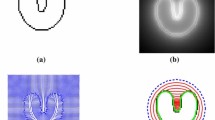Abstract
We propose a new adaptive B-spline VFC Snake model for object contour extraction. Bing Li et al. proposed vector field convolution (VFC) snake which has the advantages of superior noise robustness, reducing computational cost, and large capture range. However, it suffers from slow convergence speed due to large number of control points, as well as from difficulties in determining the weight factors associated to the internal energies constraining the smoothness of the curve. There is also no relevant criterion to determine the number of control points in VFC snake method. Our alternative approach expresses the curve as a non-uniform B-spline, in which fewer parameters are required and most importantly, internal energy calculation is eliminated because the smoothness is implicitly built into the model. A novel formulation of control points’ movement estimation was established based on the least square fitting of non-uniform B-spline curve and VFC external force for the snake evolution process. A novel strategy of adding control points quickly matches the snake to desired complex shapes. Experimental results demonstrate the capability of adaptive shape description with high convergence speed of the proposed model.
Access this chapter
Tax calculation will be finalised at checkout
Purchases are for personal use only
Preview
Unable to display preview. Download preview PDF.
Similar content being viewed by others
References
Li, B., Acton, S.T.: Active Contour External Force Using Vector Field Convolution For Image Segmentation. IEEE Transactions on Image Processing 16, 2096–2106 (2007)
Meegama, R., Rajapakse, J.: Nurbs Snakes. J. Image Vis. Comput. 21, 551–562 (2003)
Huang, Z., Cohen, F.S.: Affine-Invariant B-spline Moments For Curve Matching. IEEE Transactions on Pattern Analysis and Machine Intelligence 5, 1473–1480 (1996)
Wang, Y., Teoh, E.K., Shen, D.: Dynamic B-snake model for complex objects segmentation. J. Image Vis. Comput. 23, 1029–1040 (2005)
Paulik, M.J., Das, M., Loh, N.K.: Nonstationary Auto-regressive Modeling of Object Contours. IEEE Transactions on Signal Process 40, 660–675 (1992)
Fred, A.L.N., Marques, J.S., Jorge, P.M.: Hidden Markov Models vs Syntactic Modeling in Object Recognition. In: International Conference on Image Processing (ICIP 1997), Washington DC, USA, pp. 893–896 (1997)
Tueng, Q.M., Boles, W.W.: Wavelet-based Affine Invariant Representation: A Tool for Recognizing Planar Objects in 3D Space. IEEE Transactions on PAMI 19, 846–857 (1997)
Kass, M., Witkin, A., Terzopoulos, D.: Snakes-Active Contour Models. Int. J. Comput. Vis. 1, 321–331 (1987)
Brigger, P., Hoeg, J., Unser, M.: B-spline Snakes: A Flexible Tool for Parametric Contour Detection. IEEE Transactions on Image Processing 9, 1484–1496 (2000)
Piegl, L., Tiller, W.: The NURBS book. Springer, New York (1997)
Author information
Authors and Affiliations
Editor information
Editors and Affiliations
Rights and permissions
Copyright information
© 2010 Springer-Verlag Berlin Heidelberg
About this paper
Cite this paper
Nguyen, HN., Lee, AC. (2010). A New Adaptive B-spline VFC Snake for Object Contour Extraction. In: Pan, JS., Chen, SM., Nguyen, N.T. (eds) Computational Collective Intelligence. Technologies and Applications. ICCCI 2010. Lecture Notes in Computer Science(), vol 6423. Springer, Berlin, Heidelberg. https://doi.org/10.1007/978-3-642-16696-9_4
Download citation
DOI: https://doi.org/10.1007/978-3-642-16696-9_4
Publisher Name: Springer, Berlin, Heidelberg
Print ISBN: 978-3-642-16695-2
Online ISBN: 978-3-642-16696-9
eBook Packages: Computer ScienceComputer Science (R0)




